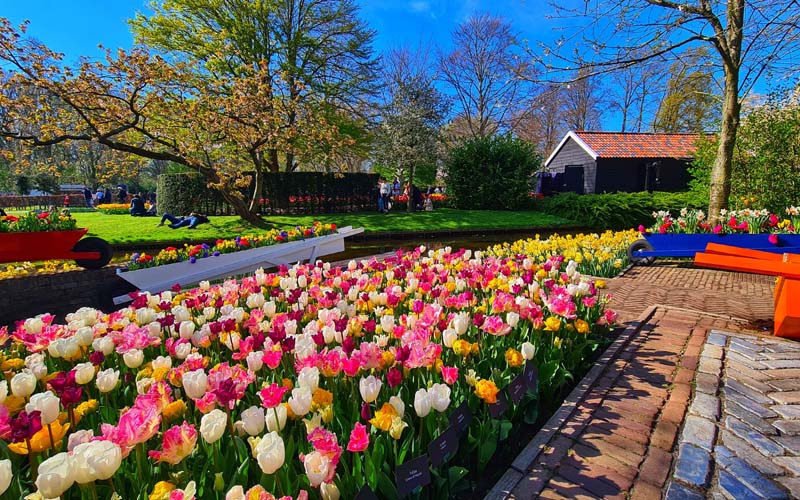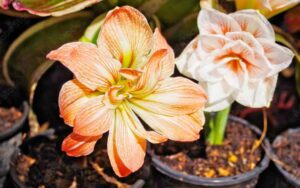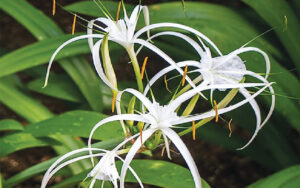Tulip springs at Venkataramannagudem
Dr. A.V.D Dorajee Rao
Professor (Hort.) & Head, COH, Venkataramannagudem
Dr. Ch.Sai Ratna Sharavani
Assistant Professor (Hort.), COH, Venkataramannagudem
Dr. T.Suseela
Professor (Hort.), COH, Venkataramannagudem
Mrs. P.Pranuthi
Assistant Professor (Hort.), COH, Venkataramannagudem
(Department of Floriculture & Landscaping, College of Horticulture, Dr.YSRHU, Venkataramannagudem-534101)
Tulip (Tulipa gesneriana L.) is known to be a temperate bulbous flower crop belonging to the family Liliaceae. It is renowned as Queen of bulbous crops. It has rich varietal wealth figuring more than 3000 in number. These are grown in beds, borders and pots for landscaping of gardens and cut flower for commercial purpose. Of late its cultivation is attempted in non-traditional areas with reportable success.
Tulips are said to be native of Turkey and Central Asia. The flowers are usually large, showy and brightly coloured, generally red, pink, yellow, or white (usually in warm colours). They often have a differently coloured blotches at the base of the tepals (petals and sepals, collectively), internally. Tulip is the National flower of Turkey and tulip motifs feature occupies prominent place in Turkish folk arts.
In India, tulips are gaining popularity among the flower growers owing to congenial climate in hilly areas, like Kashmir, Himachal Pradesh and Uttaranchal.
Nativity and Etymology
Tulips were first seen in Turkey. One species of tulip i.e. Tulipa stellata is found wild in the mid and high hills of Himachal Pradesh and T. aitchinsonii is native of Himalaya. There are around a hundred species of Tulipa originated from Turkey to the Pamir and Hindu Kush mountains in Asia, which have been used for breeding purposes.
The scientific name of this plant is Tulipa and was assigned by the famous Swedish botanist Linnaeus in mid seventeenth century. The name tulip is derived from the Persian word toliban meaning turban, which is an apt term to describe the flower shape of certain tulips.
Varieties of Tulips:
Tulip flowers are known for their exquisite beauty and fascinating range of colours. A few enthusiasts are interested to cultivate this flower crop under local conditions with an objective of introducing this novel flower. Reports revealed that there is some success of tulip cultivation under high altitudinal areas of chintapalli and lambasingi locations of coastal Andhra Pradesh.
Under the able guidance and support of Hon’ble Vice-Chancellor, Dr. YSRHU, Dr.T.Janakiram, a new initiative was taken with a mission to grow tulips under venkataramannagudem conditions. A total of thirteen varieties were procured from NEO Floritech, New Delhi. The bulbs of following tulip varieties were tested both under shade net house as well as fan and pad structures in the Centre of Excellence at Dr. YSRHU campus
| S.No. | Variety | Colour |
| 1 | Adrem | Brick red |
| 2 | Bourbon Street | Orange |
| 3 | Canasta | Red/White |
| 4 | Candela | Yellow |
| 5 | Charade | Orange |
| 6 | Madame Lafeber | Red |
| 7 | Mosni | Purple |
| 8 | Novisun | Yellow |
| 9 | Pallada | Maroon |
| 10 | Red Label | Red |
| 11 | Rescue | Red |
| 12 | Rodeo Drive | Red |
| 13 | Worlds Favourite | Red /Yellow |
Out of the above list, the following seven exhibited flowering and were attractive with varied spectrum of colours under fan & pad polyhouse and shade net.
Varieties like Mosni, Canasta, Bourbon Street and Red Label flowered under fan & pan polyhouse, whereas shade net house witnessed the first flowers of Mosni, Canasta, Rescue, Worlds Favourite and Charade

Tulip varieties bloomed at COH, Venkataramannagudem, Dr.YSRHU
General Requirements for Soil & Climate:
Soil:
Tulips require well-drained light sandy loam soils, pH of 6-7 for better growth and yield.
Soil should be low in soluble salts.
The crop cannot tolerate standing water. Bulb rot may occur in poorly drained soil. Heavy and clay soil requires the addition of sand to increase drainage.
Keeping the above points in view, the bulbs were planted in the polybags with potting mixture of red soil: vermicompost: cocopeat at 1:1:0.5 proportions
Climate:
Tulip can be grown in full sun or partial shade.
Tulip grown in hills requires a day temperature of 20-26°C and night temperature 5-12°C degrees during growth period.
Direct sun during morning and evening is beneficial for improving its flower quality, whereas partial shade is required during mid day.
Tulips are very sensitive to frost.
Even though it is difficult to grow them in hot climates, one can grow under protected structures like greenhouse and polyhouse.
With an objective to protect from the harshness of native climate, tulips were planted under shade net house and fan & pad poly house structure, wherein the temperatures were maintained below 300C.
PROPAGATION
Seeds: Tulips can be propagated by seeds which are sown in February in light sandy soil under warmth. These plants flower after 5 to 6 years. Seeds collected from open field conditions produce different shades of flowers indicating seggregation.
Vegetative:
Tulip bulbs are very much precocious as compared to seeds and therefore commercially multiplied. Plant produces 1 or 2 bulbs capable of flowering the following year while mother bulb remains intact. The flowering stock of bulbs in different varieties are depicted in the figure below

Tulip bulbs received from NEOFloritech, New Delhi
Stolons: Triploid tulips have swellings at their base which do not turn into actual bulbs but make an elongated tubular growth at the end of which a tiny bulb forms. This stolon may form in some species of tulip like Tulipa saxatilis and T. sylvestris.
Preparation of Land
Good depth of soil with adequate drainage is very important for tulip cultivation. Soil should be dug out upto 30 cm depth. It is advisable to use well rotten compost instead of animal manure.
Botrytis blight disease may develop as a result of use of the manure and this disease is very destructive. If use of manure is essential, it should be well sterilized. Compost should be properly mixed on the top soil and turned under deeply with spade or garden fork. After proper leveling of field, beds should be prepared by providing adequate drainage facilities.
Media preparation for growing in pots
Tulips can be grown in pots, media comprising of 40% red soil, 40% vermicompost and 20% cocopeat is suitable for growing tulips.
Planting and spacing
 In mid hills (1,000-1,800m above mean sea level) October-December is time of planting, whereas in high hills (above 1,800 m above mean sea level) November-December and February. The staggered planting at 15 days intervals ensures regular cut flower supply. Bulbs should be planted 5-8cm deep at 15 cm x15 cm spacing in beds.
In mid hills (1,000-1,800m above mean sea level) October-December is time of planting, whereas in high hills (above 1,800 m above mean sea level) November-December and February. The staggered planting at 15 days intervals ensures regular cut flower supply. Bulbs should be planted 5-8cm deep at 15 cm x15 cm spacing in beds. In a 15 cm pot, 3-5 bulbs should be planted. Watering in glass house/ polyhouse every alternate day is beneficial, whereas in open areas irrigation should be at weekly interval. Partial shading during mid-day is beneficial for improving scape length and flower longevity. Interculture is necessary to keep the field weeds free and makes soil porous.
Manure and Fertilizers
Low nutrition and medium EC are acceptable for tulip cultivation.
Farmyard manure at 50-100 tons/ha is to be applied at the time of land preparation. Foliar spray of 19:19:19 once in a week and micronutrient spray twice a month is suitable for proper growth and yield.
Irrigation
Soil media should be watered thoroughly after planting of bulbs. Monitoring of moisture level of media during rooting phase of bulbs is necessary. After leaves begin to expand, it is to be seen that the leaves does not get wet, hence overhead watering is to be avoided. It will be helpful to check the botrytis disease. Watering in glasshouse every alternate day is beneficial. In open areas irrigation should be done at weekly intervals.
Interculture
Weed control: Crop should be free from weeds Herbicides like carfentrazone, sulfentrazone and fluminoxazin reduced weed population upto 85% in tulip crop.
Forcing of bulbs
Few cultivars are suitable for forcing. In one of the forcing methods, bulbs are planted and allowed to root at 9°C and are then stored at -2 to -3°C for 7-8 months. On removal, they must be thawed slowly, they take 14 to 18 days to force. Such tulips are expensive because of the cost of the treatment.
For the purpose of testing at local conditions, pre-forced bulbs were procured and planted
Diseases observed
Fungal
Fusarium bulb rot or basal rot: The disease is caused by Fusarium oxysporum Schlenhtend ex Fr f. sp tulipae Apt. The first visible signs of infection on the bulbs are small, pale brown or grey sunken flecks on the outermost fleshy scales that become dark brown with age and enlarge in size. A satisfactory control is achieved by dipping bulbs for 2 hours in a 0.5% formalin solution.

Basal rot
Fire disease: It is casued by Botrytis tulipae. The leaves prior to emergence get infected. They became stunted, malformed, distorted and fail to unroll. Bulb should be dipped prior to planting in benomyl, thiabendazole or 2 per cent formalin for 30 minutes to reduce the carry over of inoculum and subsequent production of fireheads.
Pests observed
Tulip bulb aphid: This aphid Dysaphis tulipae also attacks iris, freesia, gladiolus and crocus. It is grey with a waxy appearance and clusters under bulb coats. dipping of bulbs in diazinon is required to control.

Tulip bulb Aphid
Physiological disorders noticed
Topple: It is called wet stem or water neck, when flower stem collapses and falls over late in the flower development or after the flowers picked are on the way to market. It is generally due to high temperature and localized calcium deficiency in stem.
Blind flower: In case of blind flowers, though flower initiation occurs normally but it fails to complete development and aborts at some stage after initiation. The abortion of flower may involve the flower alone or part of flower.
Harvesting
Flower: Tulip flowers are ready to harvest during February-April in the mid hills, whereas in the high hills they flower during April-June. Flowers are harvested when the entire bud is coloured but still closed.
At venkataramannagudem, under fan and pad conditions, the variety Mosni was the earliest and took 11 days for first flower bud appearance and 13 days to show colour. Canasta exhibited first flowers at 13 days after planting (DAP). Bourbon Street initiated first flowers at 15th DAP.
In shade net, the varieties Canasta, World Favourite, Charade and Rescue flowered in 12 days. Mosni followed bud initiation on 13th day.
Bulb Harvesting and Storage
Bulbs are harvested when leaves start turning yellow or 40-45 days after flowering. Old bulb scales and roots should be removed. They should be air-dried in partial shade. Putting them in wooden trays in single or double layers they are marketed. However, for quality flower production by succeeding crop, bulbs should be stored at 7-90C for 6-8 weeks during September-October for proper development of flower primodia, since tulips are very sensitive to fluctuating temperature which otherwise leads to flower abortion.
Yield
Yield of flower varies according to plant density, size of bulbs, cultural practices adopted and prevailing climatic conditions.
In general, approximately 4-5 lakh cut flowers/ha can be obtained when the bulbs are planted at a density of 50-60 bulbs/m².

Shade net house

Fan & pad polyhouse
General view of tulip varieties at venkataramannagudem at 30th DAP

Potted Tulips at flowering stage

















